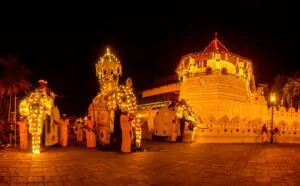
Menu
Kandy, Sri Lanka – Prepare to be mesmerized by the Kandy Esala Perahera, an annual Buddhist festival that transforms the hill city of Kandy into a vibrant tapestry of tradition, faith, and dazzling spectacle. This historic procession, often called the Festival of the Tooth, is one of the oldest and grandest cultural events in Sri Lanka, drawing thousands of pilgrims and tourists alike.
The Kandy Esala Perahera isn’t just a parade; it’s a profound cultural and religious experience. Its roots intertwine two ancient traditions the Esala Perahera, an age-old ritual to invoke rain for a successful harvest (dating back to the 3rd century BC), and the Dalada Perahera, which began in the 4th century CE when the Sacred Tooth Relic of Buddha was brought to Sri Lanka from India.
Housed at the revered Sri Dalada Maligawa (Temple of the Tooth Relic) in Kandy, this sacred relic is the focal point of the entire festival. The Perahera serves as a majestic homage to Lord Buddha and a prayer for blessings on the land and its people. It’s a living testament to Sri Lanka’s rich heritage, showcasing a unique blend of Buddhist, Hindu, and indigenous customs.
Over ten consecutive nights, typically in July or August (coinciding with the Esala full moon), the streets of Kandy come alive. Each night’s procession grows grander, culminating in the magnificent Maha Randoli Perahera.
Unveiling the Kandy Perahera’s Sacred Order and what to expect at the perarahara
Prepare to witness a mesmerizing display of devotion and cultural grandeur! The Kandy Esala Perahera unfolds as a meticulously choreographed spectacle, led by the revered Sri Dalada Maligawa (Temple of the Sacred Tooth Relic) and gracefully joined by four ancient Hindu shrines. Each evening, a unique procession contributes to the Perahera’s escalating splendor, culminating in a breathtaking unity of faiths.
As the clock strikes 8 PM, the majestic Maligawa Perahera, bearing the sacred Tooth Relic, takes its rightful place at the forefront. What follows is a captivating sequence of devotion from the surrounding Devales:
Whip Crackers (Kasakaruwo): These individuals lead the entire procession, cracking their whips loudly to announce its approach and clear the path.
Flag Bearers: Following the whip crackers are flag bearers carrying various standards, including the Buddhist flag and flags representing different provinces and temples.
Peramuna Rala: An official riding the first elephant, carrying the scroll of the temple lands.
Traditional Dancers and Drummers: Experience the rhythmic beats of traditional Kandyan drums and witness the captivating performances of various Sri Lankan dance forms, including vibrant fire dances and Kandyan Dancers (Wesnatum).
Acrobats and Performers: Fire-breathers, jugglers, and other acrobats add to the exhilarating atmosphere, clearing the path and entertaining the throngs of spectators.
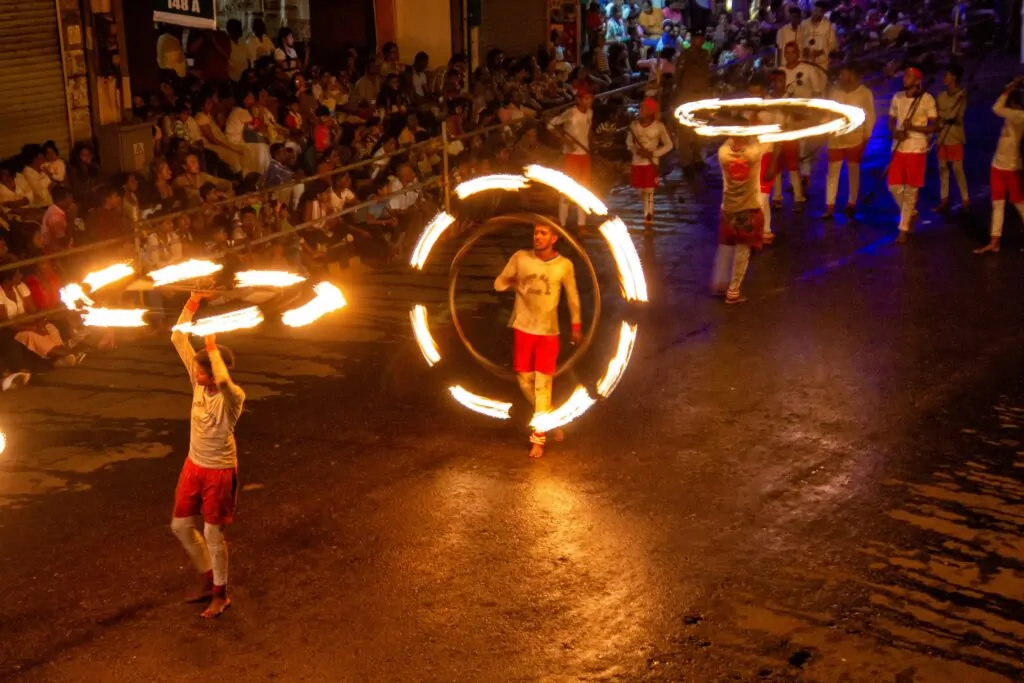
Cultural Pageantry: The procession is a vibrant showcase of Sri Lankan art, music, and traditional attire, reflecting centuries of preserved customs.
Dazzling Elephants: Majestic elephants, adorned in intricately embroidered and illuminated caparisons, gracefully parade through the streets. The most revered among them, the Maligawa Tusker, carries a golden casket containing a replica of the Sacred Tooth Relic.
Maligawa Perahera (Procession of the Sacred Temple of the Tooth): This is the central and most revered part of the Perahera. The Maligawa Tusker (the largest and most adorned elephant) carries a golden casket containing a replica of the Sacred Tooth Relic of Buddha. The tusker walks on a white cloth (pavada) laid out before it, and is accompanied by special drummers and dancers.
The Diyawadana Nilame (the lay custodian of the Temple of the Tooth and chief organizer of the Perahera) walks in splendor behind the tusker, often carrying a silver goad as a symbol of his authority. Other temple officials and numerous more dancers and elephants follow.
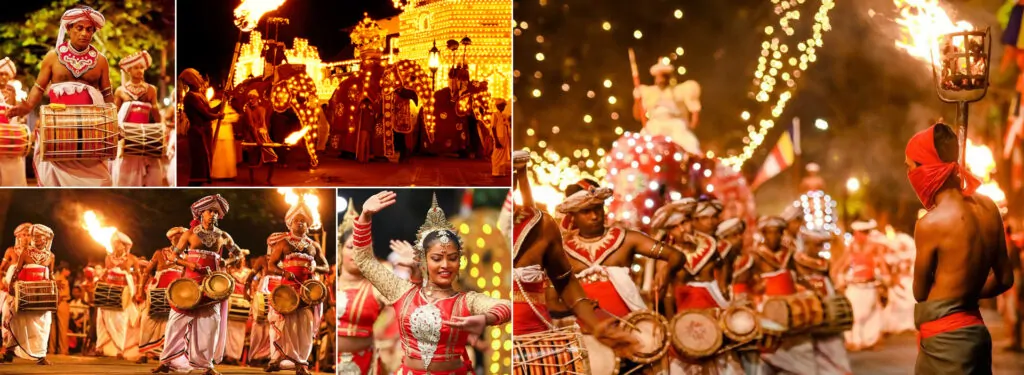
The Natha Devale Procession: Immediately behind the Maligawa comes the procession from the Shrine of God Natha. This 14th-century shrine, facing the Sri Dalada Maligawa, holds the distinction of being the oldest surviving edifice in Kandy, adding a profound historical layer to the proceedings.
The Vishnu Devale Procession: Next in line is the vibrant procession from the Shrine of God Vishnu, also known as the Maha Devale. Located in close proximity to the Natha Devale, its devotees add another wave of color and energy to the Perahera.
The Kataragama Devale Procession: The fourth procession emanates from the Kataragama Devale, dedicated to God Skanda, the deity of Kataragama. This segment is particularly enchanting, featuring the dynamic Kavadi, or peacock dance. Here, devoted pilgrims carry elaborate, semicircular wooden contraptions adorned with peacock feathers on their shoulders, adding an eye-catching element to the pageant.
The Pattini Devale Procession: Bringing up the rear is the graceful procession from the Shrine of Goddess Pattini, situated to the west of the Natha Devale. Her devotees complete the interfaith tapestry, ensuring all major deities are honored in this magnificent Kandy festival.
This meticulously ordered sequence, where Buddhist and Hindu traditions intertwine, showcases the profound spiritual harmony that underpins the Kandy Esala Perahera, making it a truly unique and unforgettable experience.
Kap Situveema: The symbolic start, where a jackfruit tree is sanctified and planted.
Kumbal Perahera: The initial five nights of processions, gradually building in grandeur (July 30th – August 3rd, 2025).
Randoli Perahera: The final five nights, where the processions reach their peak in splendor and scale (August 4th – August 8th, 2025).
Diya Kepeema: The traditional water-cutting ceremony, marking the festival’s conclusion (August 9th, 2025).
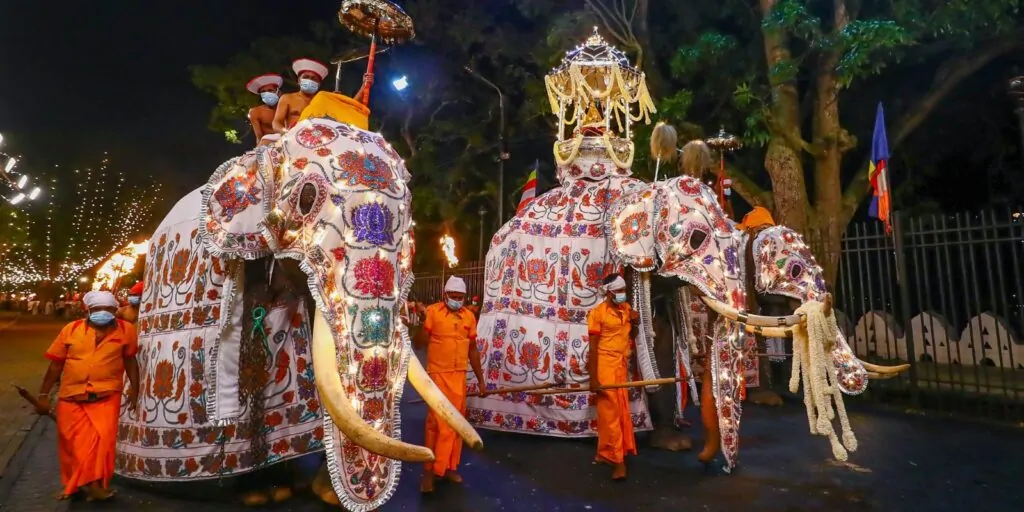
To make the most of this once-in-a-lifetime experience:
Choose date : starting kmubal perahera is small scale and few items but its less crowd in those days. Better to choose date in middle of randoli perahara last date is the biggest one but its too much crowd.
Book Accommodations Early: Kandy becomes extremely busy during the Perahera. Secure your hotel in advance. If you can find a hotel near to the perahera road that would be perfect because most of the time the city area roads are close to vehicles due to heavy traffic. The Queens hotel kandy is the best place because it is right in front of the maligawa and perahara goes in front of the hotel
Secure Viewing Spots: Prime viewing spots along the procession route are highly sought after. Consider booking a seat on a rented balcony or arriving very early to claim a good street-side spot. Recommended to book a seat in advance and the prices can be vary according to the view and the spot. If you can find spot in arriving road side that would be perfect otherwise you have to spend whole night until early in the morning if you got spot in departure side.
Dress Respectfully: As a religious festival, modest attire is recommended, especially when visiting the Temple of the Tooth. (should be cover from your shoulders to knees)
Stay Hydrated: The crowds and excitement can be intense; carry water and food stay refreshed. Once it started you can’t go anywhere so remember to bring all your stuff
For all your travel needs, feel free to contact us!
Let ceylonsilkroute transform your travel dreams into an unforgettable Sri Lankan reality.
The Kandy Esala Perahera is more than just a festival; it’s a profound cultural immersion that connects you to the heart and soul of Sri Lanka. Witnessing this ancient tradition is an unforgettable journey into faith, history, and dazzling artistic expression.
#KandyEsalaPerahera #SriLankaFestival #FestivalOfTheTooth #SriDaladaMaligawa #Kandy #SriLankaTravel #CulturalHeritage #BuddhistFestival #EsalaPerahera #TravelSriLanka
Explore the surrounding areas of Kandy, including the Temple of the Tooth, Kandy Lake, museum and the Royal Botanical Gardens, to fully appreciate the city’s charm. If you are planning to explore those places in the festival season remember that you have to visit in the morning time otherwise it would be crowded with heavy traffic from the afternoon.
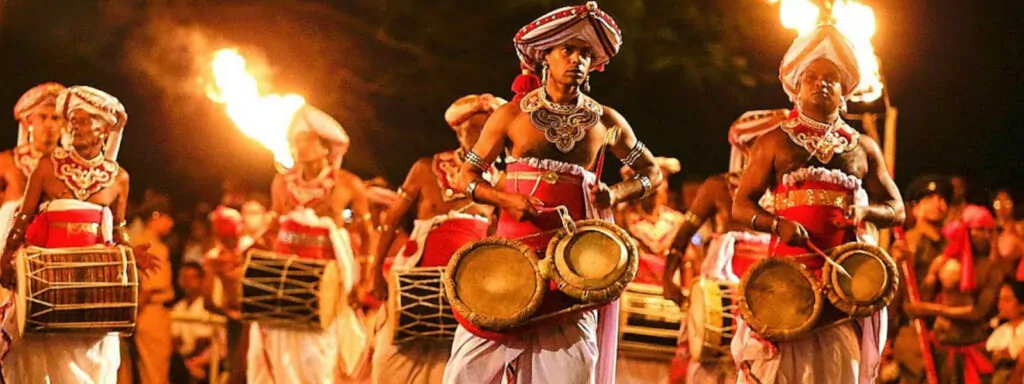

The Temple of the Tooth Relic, locally known as Sri Dalada Maligawa, is not merely a temple but the spiritual heart of Sri Lanka and a UNESCO World Heritage Site. Located in the picturesque city of Kandy, this revered Buddhist temple holds the Sacred Tooth Relic of Lord Buddha, making it one of the most significant pilgrimage sites in the Buddhist world.
Legend states that the tooth was smuggled to Sri Lanka from India in the 4th century CE, hidden in the hair of a princess. Since then, it has been a potent symbol of sovereignty, with the belief that whoever possesses the relic holds the right to rule the country. This historical connection has elevated the temple’s importance far beyond its religious significance.
Architecturally, the Temple of the Tooth showcases a unique blend of traditional Kandyan and South Indian styles. Its golden roof and white stone walls, adorned with intricate carvings and frescoes, are a sight to behold. The relic itself is encased in a series of golden caskets, housed within a heavily guarded inner chamber, and while the actual tooth is rarely seen by the public, its presence inspires immense devotion.
Daily rituals (poojas) are performed three times a day by Buddhist monks, accompanied by traditional drumming and offerings, creating a deeply spiritual atmosphere.
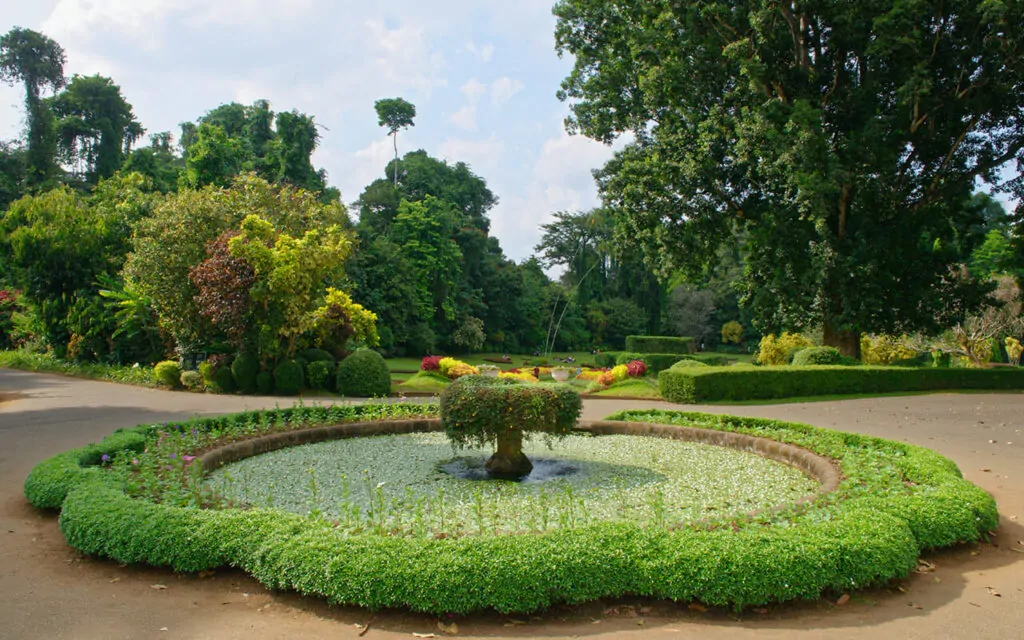
Just a short drive from the city center of Kandy lies the magnificent Royal Botanic Gardens, Peradeniya, a sprawling horticultural paradise that ranks among the finest in Asia. Covering over 147 acres, this exquisitely maintained garden is renowned for its stunning collection of diverse plant species, both indigenous and exotic.
Established officially in 1843 by the British, the gardens have a history dating back to the 14th century when the area served as a pleasure garden for Kandyan royalty. Today, it’s a living museum of flora, attracting botanists, nature lovers, and casual visitors alike.
The Orchid House a breathtaking display of over 300 varieties of orchids, showcasing their delicate beauty and vibrant colors. The Avenue of Palms a majestic pathway lined with towering royal palms, creating an impressive natural archway.
The Spice Garden an aromatic section dedicated to Sri Lanka’s renowned spices, offering insights into their cultivation and uses. Medicinal Plant Garden showcasing the traditional herbs and plants used in Ayurvedic medicine.
Beyond its aesthetic appeal, the gardens play a crucial role in botanical research, conservation, and education. It’s a tranquil oasis where visitors can wander for hours, immersing themselves in the beauty and diversity of the plant kingdom. The Royal Botanic Gardens is an essential stop for anyone visiting Kandy, offering a refreshing and educational experience amidst natural splendor

Nestled amidst the misty hills near Kandy, Loolkandura Estate holds immense historical significance as the birthplace of the commercial tea industry in Sri Lanka (then Ceylon). It was here, in 1867, that James Taylor, a pioneering Scottish planter, successfully established the island’s very first tea plantation.
After coffee crops were devastated by blight, Taylor’s experimental tea planting on a mere 19 acres at Loolkandura proved to be a revolutionary success, laying the foundation for what would become Sri Lanka’s most iconic export – Ceylon Tea.
Today, visitors to Loolkandura can step back in time and explore key historical sites, including Field No. 7 The very first tea patch planted by Taylor, still visible today. Taylor’s Seat a rock where James Taylor often sat, overlooking the burgeoning tea fields and contemplating his vision. Taylor’s Well: The original well used by the pioneer. The first tea factory though much has evolved, remnants of the initial processing facilities can be seen.
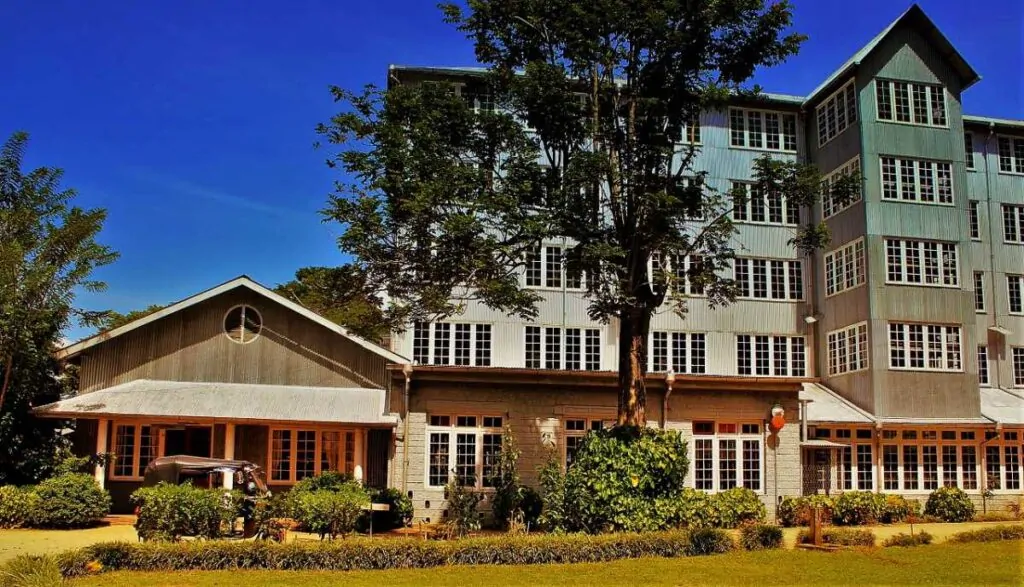
Sri Lanka is famous for its world class tea. If you are tea lover or a history enthusiast, the Ceylon tea museum in Hantana is a must visit destination. Nestled in the hills just outside Kandy this museum is a tribute to Sri Lankan tea heritage offering visitors a deep dive into the island’s fascinating tea industry. From learning about early tea production to sampling authentic Ceylon tea there’s plenty to explore.
The Ceylon tea museum housed in a refurbished four-story tea factory built in the 1920s, Beautifully preserves Sri Lanka’s tea history. Located in Hantana about four kilometers south of Kandy, the museum offers panoramic views of the surrounding hills and valleys –a perfect backdrop to your tea exploration
Its more than just a museum it’s an experience. From historical exhibits to interactive sessions with the tea experts visitors get an insider’s view in to the one of the world’s favorite beverage
The museum is open Tuesday to Sunday from 8:30am to 4:30Pm. Best time to visit is morning or late afternoon as the weather is cooler and views are the breathtaking
The museum first two floors are dedicated to the history of tea production in Sri Lanka. You will find antique tea-processing machinery and equipment used in the industry’s early days. Learn about the pioneering efforts of James Taylor the British planter who introduced tea cultivation in Sri Lanka in the 19th century
Interesting fact did you now coffee plantation once dominated Sri Lanka before shifting to tea due to a coffee rust epidemic. This museum preserves that transformation in detail.


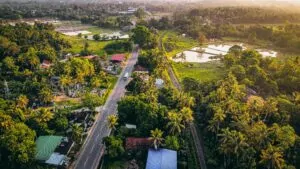
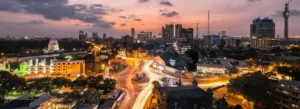

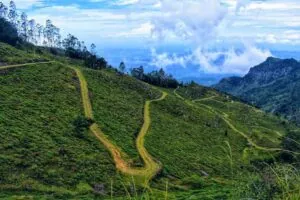
WhatsApp us